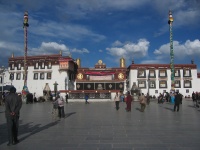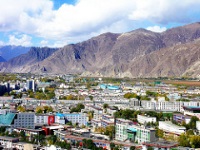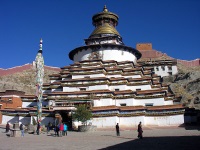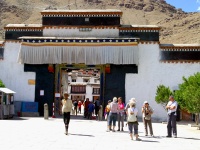
The Jokhang Temple lies in the heart of old Lhasa. It was built nearly 1,300 years ago but remains the spiritual centre of Tibet, drawing pilgrims from all over the region who come to demonstrate piety to the Buddha. The original structure was enlarged under the reign of the Fifth Dalai Lama and it now stands as the product of Han, Tibetan and Nepalese architectural design. It is a four-storey timber temple with a golden roof and it contains numerous valuable cultural relics and sacred sculptures, and features some magnificent murals in the main hall. Possibly the most special statue is the site's original sculpture of Buddha, called Jobo, which is richly decorated with jewels and silk. An annual prayer festival is held in the temple, which is also the venue for the initiation of the Dalai Lamas. The Jokhang Temple is a UNESCO World Heritage Site and it is generally considered to be Tibet's most sacred and important temple. It is certainly one of the most popular tourist attractions in Lhasa. By all accounts, Jokhang Temple is a profoundly special place and it is said that travellers who stay long enough will discover that they are a Buddhist.
Address : Chengguan, Lhasa
Website : jokhang.org
Telephone : 891 633 6858

Lhasa is a holiday destination set in a marshy valley and dominated by surrounding mountain peaks. It is the capital city of the Tibet Autonomous Region and one of the highest cities in the world, at an elevation of 12,000ft (3,658m). Lhasa has long been the religious, cultural and political centre of Tibet, sheltered from the harsh winds of the Tibetan plateau in a spot that has been inhabited from at least 1500 BC. Today Lhasa has a population of more than 400,000. Being the religious centre for Lamaist Buddhists since ancient times, flocks of pilgrims have made their way to Lhasa over the centuries to worship at the feet of the Dalai Lama. Now tourists on holiday are following in their wake to explore the surrounding mountains and investigate Tibet's unique culture and long history.In 1959 Lhasa saw several days of warfare in a revolt against communist reforms being imposed by the Chinese administration. The Dalai Lama fled to India and communism was instituted in Tibet. Many historic and religious buildings were destroyed, and Tibetan traditional culture discouraged. With political reform having taken root in China, however, economic progress has reached Lhasa as well and the city is currently enjoying a period of rapid modernisation, while retaining its importance as a holy city for Lamaist Buddhism. The remaining historic buildings are drawing more and more holiday visitors to Lhasa.

The Shigatse prefecture is the gateway for climbers to the North Col climbing route of the world's highest mountain, Mount Everest. The ultimate climber's challenge, Mount Everest towers at 29,028 feet (8,848m) on the border between Tibet and Nepal. The Tibetan name for the peak is Mount Quomolangma, which means 'the third goddess'. Access to the Everest Base Camp is via the town of Tinggri. About 20 miles (30km) from the town hiking tracks take climbers on a 48-mile (78km) trek to the first camp.About six miles (10km) from the base camp is the highest monastery on earth, Rongbuk Monastery, at an altitude of 16,728ft (5,099m). The monastery is being restored and offers hostel accommodation. Just south of the monastery is the world-renowned Rongbuk Glacier. Because of its height, adventurers wishing to climb Mount Everest will need to allow several weeks simply to acclimatise to the thin atmosphere. Climbing Mount Everest is not to be entertained without the aid of a guide, and should only be attempted by extremely experienced climbers. Many have died attempting to reach the summit - about 280 people are thought to have perished on the mountain and fatalities occur almost every year. However, it is an awe-inspiring area to explore even for travellers not intending to climb the peak.Numerous travel agencies offer package multi-day hikes around the area and up to the Everest base camp.

The unique Palkhor (Baiju) Monastery is situated about 143 miles (230km) south of Lhasa and 62 miles (100km) east of Shigatse, at the foot of Dzong Hill. It has an unusual structural style and houses a collection of pure silk costumes worn in Tibetan opera, all richly embroidered, that date from the Ming and Qing Dynasties. The architecture of the monastery is diverse, incorporating Han, Tibetan and Nepali styles. The monastery is also unique in that it is the only one known to accommodate monks from three different Buddhist orders: the Gelugpa, Sakyapa and Kahdampa monks all get along famously. The main hall of Palkhor Monastery is about 500 years old. This famous monastery is a popular pilgrimage site and houses a number of shrines and frescoes: the 18 Arhat clay sculptures in the Arhat Shrine are renowned throughout Tibet. The most famous attraction of the monastery, however, is the Bodhi Dagoba, a building consisting of nine tiers, with 108 gates, that houses 76 shrines to Buddha. The views in the area are phenomenal and visitors will be enchanted by the location and the devotion of the pilgrims who flock to the site.
Address : Gyangze, Shigatse

The vast Potala Palace stands on a cliff top above Lhasa, considered the greatest achievement of Tibetan architecture. The palace was originally built in the 7th century by the then emperor for his bride. It was later partially destroyed by lightning, and war, but restored and extended in 1645 by the Fifth Dalai Lama when he became political and religious leader of Tibet. The Fifth Dalai Lama took up residence in the palace in 1653, and it remained the Dalai Lamas' official residence until the exile of the 14th Dalai Lama in 1959.The palace is renowned for its interior splendour. It consists of two main sections: The White Palace is the secular section containing offices, dormitories, a Buddhist seminary and printing house; The Red Palace is the sacred sanctuary dedicated to religious study and Buddhist prayer. The Red Palace contains chapels where the mummified remains of three Dalai Lamas lie, and the Great West Hall famous for its rich murals. The only remaining structures dating from the 7th century are the Dharma Cave and the Saint's Chapel but the palace houses many ancient cultural treasures and relics. In fact, the palace contains over 10,000 shrines and 200,000 statues.
Address : 35 Beijing Middle Rd, Chengguan, Lhasa, Tibet
Website : www.potala-palace.com
Telephone : 139 899 87403
Opening times : Daily 9.30am-2pm

Tashi Lhunpo is one of Tibet's most revered and influential monasteries, lying about a mile (2km) to the west of Shigatse at the base of Drolmari Mountain. It dates from 1477, having been founded by the first Dalai Lama, and became the seat of the Panchen Lama (Tibet's second most important spiritual leader) in 1713. The monastery today houses about 800 monks in its 3,229 square foot (300 sq m) buildings. The oldest section of the monastery is the main chanting hall that houses the throne of the Panchen Lama. The tallest section is the Maitreya Chapel, which contains the world's largest brass statue of Maitreya. The seated figure is 86 feet (26m) high and has been decorated with gold, pearl, amber, copper, coral, diamonds, and many other precious stones. It is said that it took 900 craftsmen nine years to complete the statue. The Tashi Lhunpo Monastery boasts many other treasures, including the remarkable Thanka Wall, which is nine floors high and was built by the first Dalai Lama. The wall is used to display massive images of Buddha on important days in the Tibetan Lunar Calendar. There are also exquisite wall paintings, or murals, to be found within the monastery.
Address : 7 Jijilangka Road, Shigatse
Website : www.tashilhunpo.org

Travel Guide powered by Word Travels, copyright © 2023 Globe Media Ltd. By its very nature information in this travel guide is subject to change at short notice and travellers are urged to verify information on which they're relying with the relevant authorities. Neither Globe Media Ltd nor Travel Vogue can accept any responsibility for any loss or inconvenience to any person as a result of information contained above.